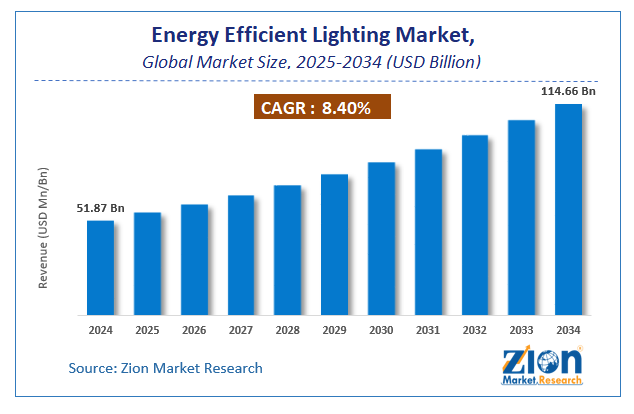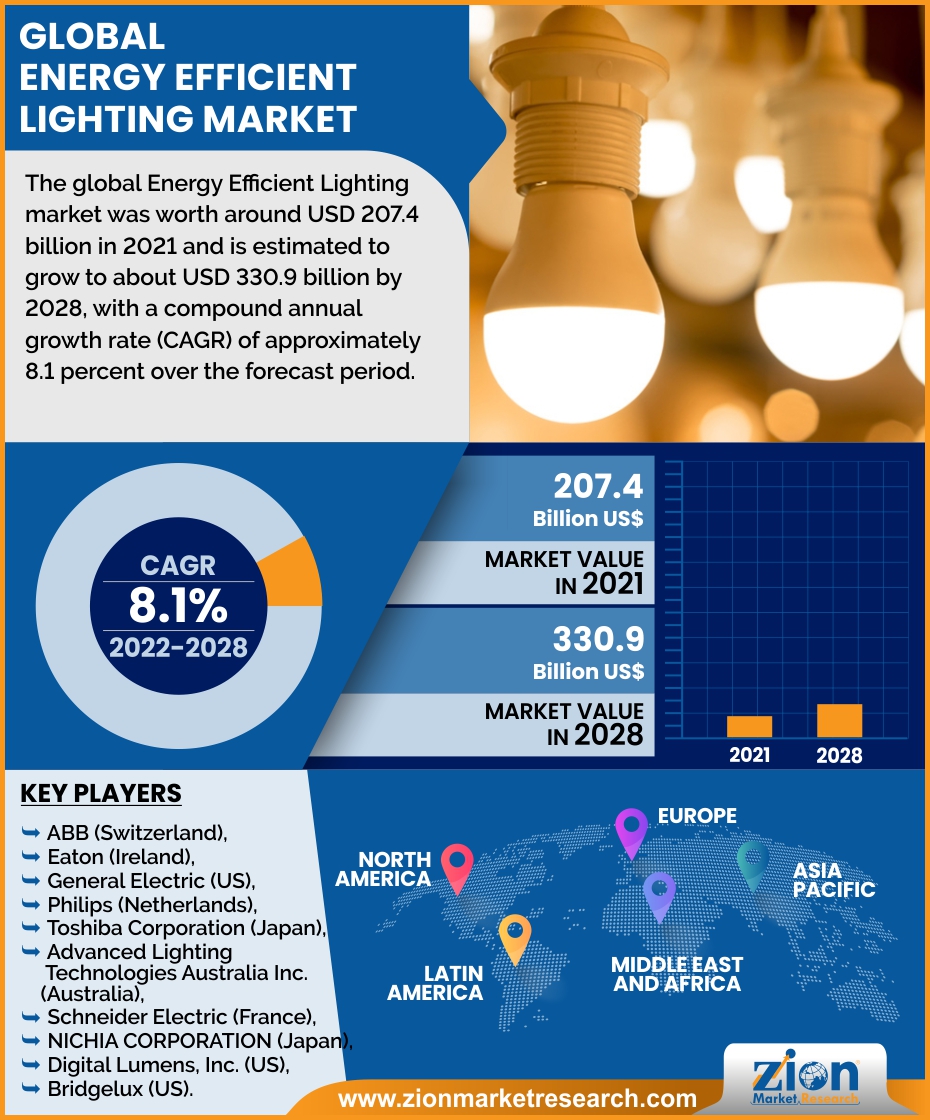Energy Efficient Lighting Market Size, Share Report, Analysis, Trends, Growth 2028

Energy Efficient Lighting Market By Product (Fluorescent Lamps, Compact Fluorescent Lamps (CFLs), LED Lamps, High Intensity Discharge (HID) Lamps, Induction Lamps), By End use (Residential, Commercial, Industrial, Outdoor), and By Region - Global and Regional Industry Overview, Market Intelligence, Comprehensive Analysis, Historical Data, and Forecasts 2022 - 2028
| Market Size in 2021 | Market Forecast in 2028 | CAGR (in %) | Base Year |
|---|---|---|---|
| USD 207.4 Billion | USD 330.9 Billion | 8.1% | 2021 |
Industry Prospective:
The global Energy Efficient Lighting market was worth around USD 207.4 billion in 2021 and is estimated to grow to about USD 330.9 billion by 2028, with a compound annual growth rate (CAGR) of approximately 8.1 percent over the forecast period. The report analyzes the Energy Efficient Lighting market’s drivers, restraints/challenges, and the effect they have on the demands during the projection period. In addition, the report explores emerging opportunities in the Energy Efficient Lighting market.
Energy Efficient Lighting Market: Overview
Energy Efficient Lighting are lighting solutions which are focused on conservation of energy and sustainability in order to provide a better low consumption alternative. Increasing demand for energy and rising focus on sustainability are factors that will majorly influence the energy efficient lighting market potential over the forecast period.
Increasing focus on sustainability, rising consumer preference of energy conservation, shift in consumer preferences from conventional lighting methods to energy efficient ones are other factors that will guide the energy efficient lighting market potential through 2028.
High implementation and installation costs of energy efficient lighting are estimated to have a hindering effect on the global energy efficient lighting market potential over the forecast period.
Technological advancements in the lighting systems not only provide energy efficiency but also offer additional benefits such as light ambiance, ventilation, and warmth. In addition, these lighting devices add the aesthetic beauty of the house and eliminate the need for artificial heating and cooling. The government initiatives for energy saving in order to maintain sustainability and eco-friendly environment are also factors that are fueling the growth of the market. The energy cost differs among developing and developed countries, governments of respective countries are formulating rules and regulations in order to ensure adequate power generation. In comparison to traditional lighting devices, the energy-efficient lighting devices such as LED and CFL aid the organizations in the conservation of energy and cost-effectiveness. Thus, the rising need and demand for energy-efficient lighting are boosting the market growth and development.
COVID-19 Impact:
The COVID-19 pandemic led to some changes to the energy efficient lighting market, but these were not so harsh as they were on the other markets that nearly crumbled under the adverse economic conditions in 2020. The energy efficient lighting market saw a drop in manufacturing and sales activities owing to multiple lockdown restrictions across various nations.
The energy efficient lighting market is predicted to make a swift recovery in the post-pandemic era as the world returns to normal, and this will majorly be driven by increasing demand for energy efficient solutions as the world grapples from the increasing demand for energy. The energy efficient lighting market will also be driven by the increasing popularity of sustainability trends as well.
Energy Efficient Lighting Market: Growth Drivers
Increasing Demand for Energy Conservation
The world is experiencing a major population boom and this trend has substantially impacted multiple markets. This increasing population has also resulted in a huge uproar for energy consumption, which the world is not ready for yet. The depleting non-renewable resources that are used for energy generation have also promoted the use of energy efficient systems, and hence these factors are projected to boost the demand for energy efficient lighting over the forecast period.
Energy Efficient Lighting Market: Restraints
High Costs Associated with Implementation
Energy Efficient Lighting systems and solutions require high initial investment as there are multiple components that need to be installed in order to shift from conventional lighting setups and this has a hampering effect on the energy efficient lighting market growth. Energy efficient lighting companies are focusing on launching new and affordable solutions in order to overcome this barrier and unleash the full growth potential to maximize revenue streams.
Energy Efficient Lighting Market: Report Scope
| Report Attributes | Report Details |
|---|---|
| Report Name | Energy Efficient Lighting Market |
| Market Size in 2021 | USD USD 207.4 Billion |
| Market Forecast in 2028 | USD USD 330.9 Billion |
| Growth Rate | CAGR of 8.1% |
| Number of Pages | 184 |
| Key Companies Covered | ABB (Switzerland), Eaton (Ireland), General Electric (US), Philips (Netherlands), Toshiba Corporation (Japan), Advanced Lighting Technologies Australia Inc. (Australia), Schneider Electric (France), NICHIA CORPORATION (Japan), Digital Lumens, Inc. (US), Bridgelux (US). |
| Segments Covered | By Product, By End use and By Region |
| Regions Covered | North America, Europe, Asia Pacific (APAC), Latin America, Middle East, and Africa (MEA) |
| Base Year | 2021 |
| Historical Year | 2016 to 2020 |
| Forecast Year | 2022 - 2028 |
| Customization Scope | Avail customized purchase options to meet your exact research needs. Request For Customization |
Global Energy Efficient Lighting Market: Segmentation
The global Energy Efficient Lighting market is segregated based on fiber type, Product, end use, and region.
By Product, the market is divided into Fluorescent Lamps, Compact Fluorescent Lamps (CFLs), LED Lamps, High Intensity Discharge (HID) Lamps, and Induction Lamps. The LED lamps segment is expected to hold a dominant market share and this trend is predicted to be the most lucrative segment over the forecast period as well. Increasing benefits of the use of LED and supportive government initiatives are anticipated to boost the growth in this segment.
By End use, the energy efficient lighting market is segmented into Residential, Commercial, Industrial, and Outdoor. The industrial and outdoor segments are expected to be the most lucrative segments in the global energy efficient lighting market and will majorly influence the industry growth through 2028.
Recent Developments
- In April 2022 – Electrical Safety Foundation International (ESFI) announced the launch of a national effort to bolster electrical safety and also promote the use of energy efficient lighting and energy conservation systems in Arlington, Virginia, United States.
Regional Landscape
Europe has bolstered its focus on energy efficiency and lower carbon footprint, and this has led to a major increase in the adoption of novel sustainability technologies. This region is predicted to have the most bright outlook over the forecast period, owing to its increasing regulations supporting sustainable alternatives to attain zero carbon footprint. Energy efficient lighting solutions are predicted to see high demand, owing to increasing subsidies for their deployment by multiple government initiatives. Germany, the United Kingdom, and France are expected to be the most lucrative markets for energy efficient lighting industry growth over the forecast period.
The market for Energy Efficient Lighting in the Asia Pacific is also anticipated to provide beneficial opportunities owing to the rising focus on energy saving and energy management due to the increasing demand for energy from the growing population.
Competitive Landscape
Some of the main competitors dominating the global Energy Efficient Lighting market include -
- ABB (Switzerland)
- Eaton (Ireland)
- General Electric (US)
- Philips (Netherlands)
- Toshiba Corporation (Japan)
- Advanced Lighting Technologies Australia Inc. (Australia)
- Schneider Electric (France)
- NICHIA CORPORATION (Japan)
- Digital Lumens, Inc. (US)
- Bridgelux (US).
Global Energy Efficient Lighting market is segmented as follows:
By Product
- Fluorescent Lamps
- Compact Fluorescent Lamps (CFLs)
- LED Lamps
- High Intensity Discharge (HID) Lamps
- Induction Lamps
By End use
- Residential
- Commercial
- Industrial
- Outdoor
By Region
- North America
- The U.S.
- Canada
- Europe
- France
- The UK
- Spain
- Germany
- Italy
- Rest of Europe
- Asia Pacific
- China
- Japan
- India
- South Korea
- Southeast Asia
- Rest of Asia Pacific
- Latin America
- Brazil
- Mexico
- Rest of Latin America
- Middle East & Africa
- GCC
- South Africa
- Rest of Middle East & Africa
Table Of Content
Methodology
FrequentlyAsked Questions
Increasing focus on sustainability, rising investments in energy conservation and strict government mandates to conserve energy are some major trends that guide Energy Efficient Lighting market growth.
According to the Market Research report, the global Energy Efficient Lighting market was worth about US$ 207.4 billion in 2021 and is predicted to grow to around US$ 330.9 billion by 2028, with a compound annual growth rate (CAGR) of around 8.1 percent.
The Europe region is predicted to have the most bright outlook over the forecast period owing to its increasing regulations supporting sustainable alternatives to attain zero carbon footprint.
Some of the main competitors dominating the global Energy Efficient Lighting market include -- ABB (Switzerland), Eaton (Ireland), General Electric (US), Philips (Netherlands), Toshiba Corporation (Japan), Advanced Lighting Technologies Australia Inc. (Australia), Schneider Electric (France), NICHIA CORPORATION (Japan), Digital Lumens, Inc. (US), Bridgelux (US).
RelatedNews
HappyClients
Zion Market Research
Tel: +1 (302) 444-0166
USA/Canada Toll Free No.+1 (855) 465-4651
3rd Floor,
Mrunal Paradise, Opp Maharaja Hotel,
Pimple Gurav, Pune 411061,
Maharashtra, India
Phone No +91 7768 006 007, +91 7768 006 008
US OFFICE NO +1 (302) 444-0166
US/CAN TOLL FREE +1 (855) 465-4651
Email: sales@zionmarketresearch.com
We have secured system to process your transaction.
Our support available to help you 24 hours a day, five days a week.
Monday - Friday: 9AM - 6PM
Saturday - Sunday: Closed







